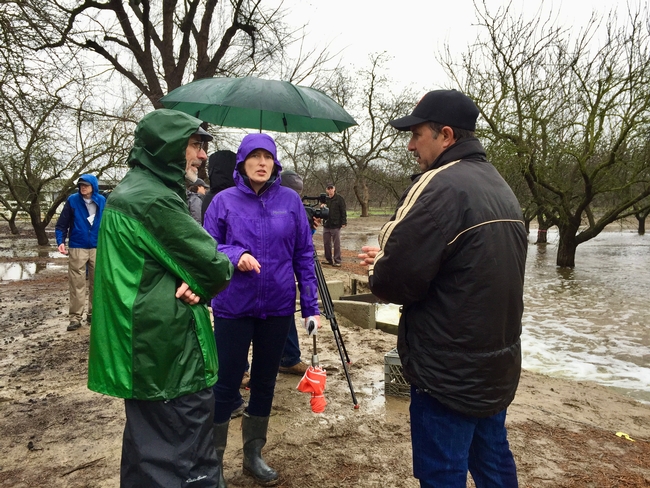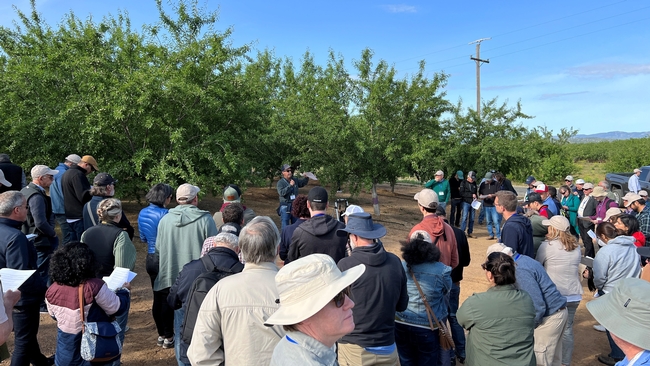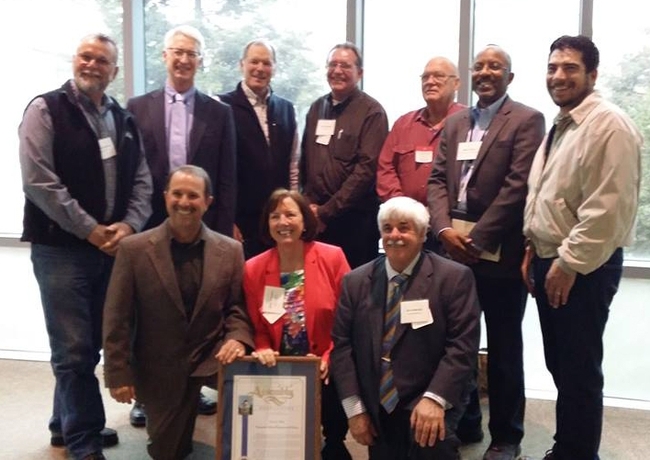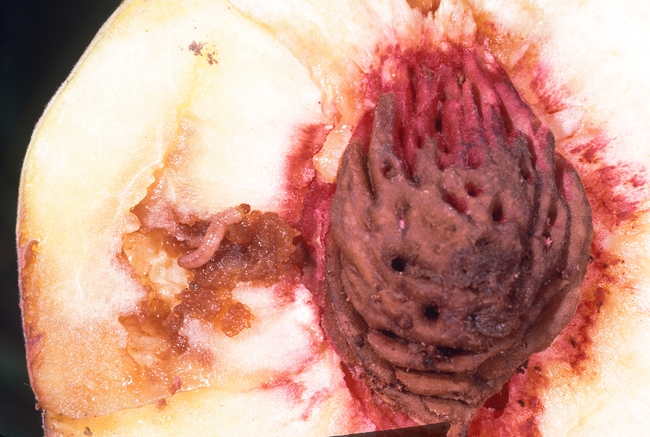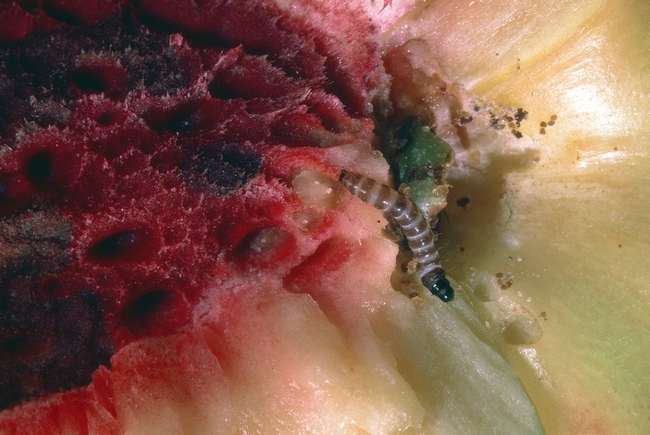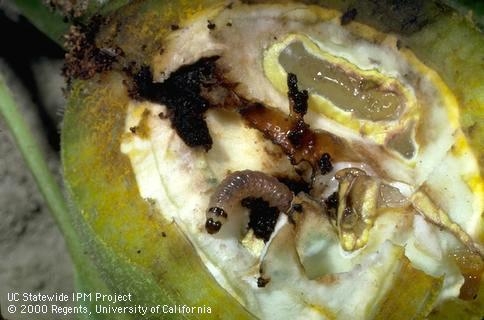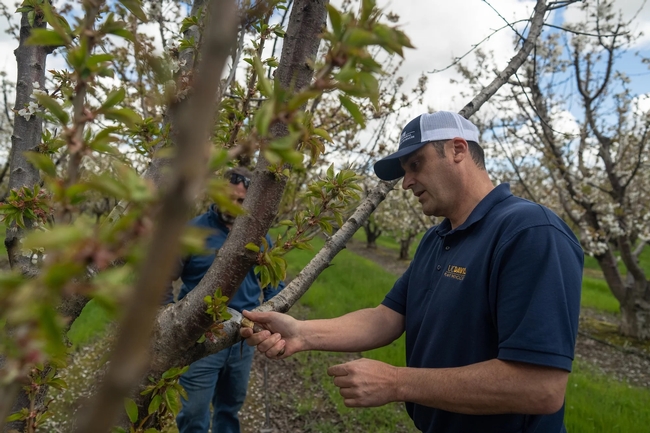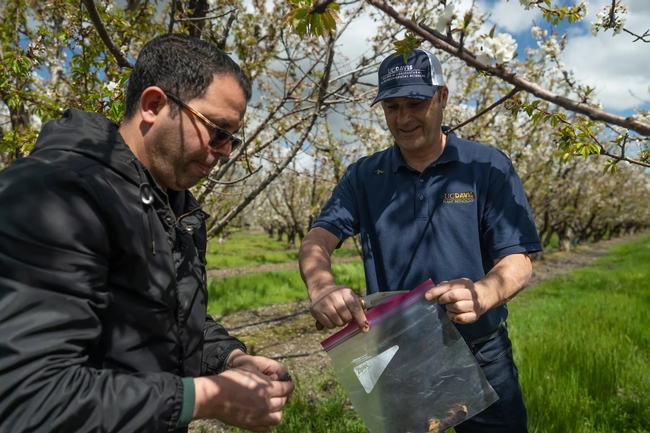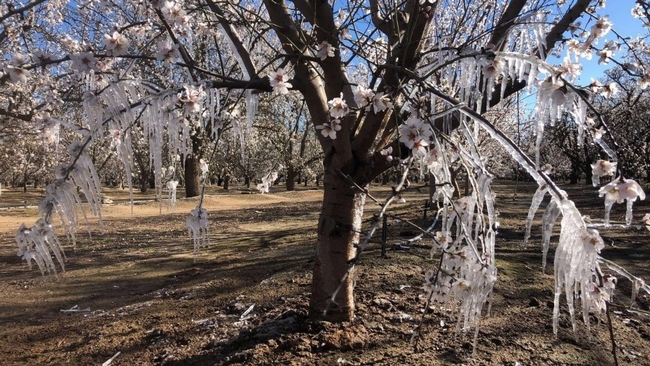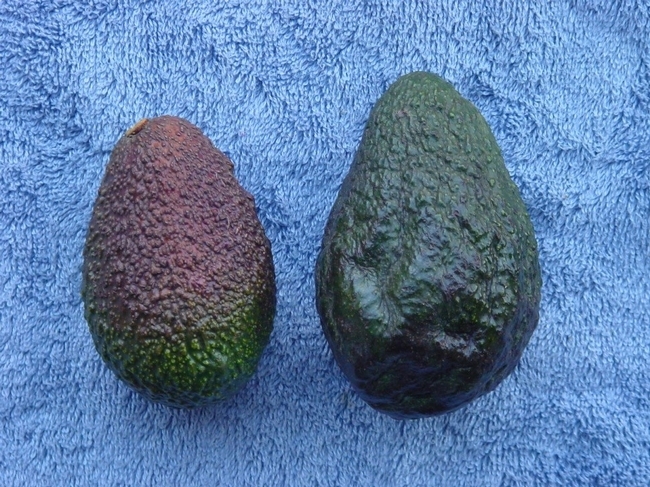
Posts Tagged: almonds
Duncan’s research ‘blew up preconceived ideas,’ improved almond, peach, grape production
Roger Duncan, UCCE farm advisor in Stanislaus County, retires after 36 years
For more than three decades, tree fruit and nut growers have depended on the advice of Roger Duncan, UC Cooperative Extension pomology farm advisor in Stanislaus County, to improve their production practices. Duncan, whose research and extension program focused on almonds, peaches, grapes and other tree crops, retired July 1.
“Roger Duncan has been an extraordinarily relevant researcher for the predominant crops in Stanislaus County,” said Rep. John Duarte, owner of Duarte Nursery in Hughson. “His research has encompassed rootstock and variety selection, tree spacing, chemical inputs and spraying, fertilizers, pruning and replanting amongst other projects.”
Duncan began working for UC ANR in 1988 as a field assistant to Integrated Pest Management advisor Jim Stapleton after earning a master's degree in plant science and plant pathology from Fresno State and a bachelor's degree in the same subjects from UC Davis. In 1990, he became a UC Cooperative Extension in pomology farm advisor in Stanislaus County.
During Duncan's tenure, the planted acreage of tree and vine crops has tripled in Stanislaus County to nearly 1,900 farms on over 230,000 acres. His research has helped to improve production efficiency through improved rootstocks, crop varieties and production practices.
“Roger provides growers with resources and tools on nutrition, sprays, nutrient deficiencies, calendars, costs, pest management and other horticultural practices,” Duarte said. “His work has had significant impact on the productivity and quality of almonds, peaches and grapes. Breeders, universities, nurseries, growers and marketers have all gained from the wisdom and dedication of Roger Duncan.”
Growing up in Modesto, Duncan wasn't raised on a farm. “I had friends whose families farmed orchard crops, so I had some exposure,” he said. “I caught the Extension bug while working as a summer intern for the pomology advisors in the Stanislaus County UCCE office after I graduated with my B.S. That is what inspired me to return to school with the goal of being a pomology farm advisor.”
Reducing production costs
To help growers lower production costs, Duncan introduced orchard practices aimed at reducing hand labor and other inputs. As a result of his research, minimal pruning has become the norm in California almond production, reducing input costs and carbon output and increasing yield. He also improved monitoring and management techniques of established and invasive diseases and insect pests.
“The practical applications Roger brings to the grower community are invaluable,” said Mel Machado, Blue Diamond Almonds vice president for member relations and Stanislaus County almond grower. “His minimal pruning study stood growers on their heads. People had preconceived ideas about pruning. He blew that up. His research showed that after you get the tree's frame, all you need to remove are the dead and occluded branches. With the market depressed, we needed to cut costs. He said, ‘You don't need pruning.' Now I'm growing bushes.”
Art Bowman, a crop adviser with Salida Ag Chem, agreed that Duncan's pruning research had an impact. “Roger's pruning trial that lasted over 20 years was a much-discussed subject among growers,” Bowman said. “Growers' pruning practices definitely changed due to Roger's research, with early emphasis on structural development and, later in the tree's life, concentrating on tree accessibility and deadwood removal.”
In 1990, when Duncan joined UC Cooperative Extension, California had 408,700 acres of almonds, according to the California Agricultural Statistics Service. Now the state has over 1.5 million acres of almonds.
About 75% of the farms Duncan has served have 40 acres or less, farmed by “small” or “part-time” farmers, who needed to learn basic horticulture and pest management. Stanislaus County also is home to some very large, sophisticated growers, who Duncan has kept apprised of new technology.
“I believe that personal interaction offers the most memorable means of information transfer, which is why I held an average of 12-plus extension events per year, gave 18-plus extension presentations per year, and went on an average of over 75 individual farm calls per year,” Duncan said. He also provided information via videos, blogs, podcasts, radio shows, newsletters, news media and extension publications as well as commodity boards.
Along with Duncan's research, Bowman has appreciated his availability. “Roger was always ready to take a call, make orchard visits and listen to a grower's concern or problem,” he said.
In 1997, Duncan began hosting twice monthly Tree & Vine Integrated Pest Management breakfast meetings for pest control advisers and growers to discuss current and potential pest threats. These meetings have continued for 28 years.
He speaks ‘farmer'
Machado attributes much of Duncan's success to his communication skills. “His research is scientific and he speaks ‘farmer,'” he said.
Machado gave rootstock as an example. “Roger is my rootstock resource; he knows rootstocks better than anybody,” he said. “His rootstock trial is dirt simple. There's a different rootstock every five trees. You can see walking down the row the differences in the rootstocks.”
From his field evaluations, Duncan identified a complex hybrid rootstock that is highly tolerant to ring nematode, bacterial canker and salt toxicity. He found other hybrid rootstocks that boost crop yield while reducing risk from soil chemistry and soil-borne disease challenges, enabling almonds to be grown in the marginal soils on the west side of the North San Joaquin Valley. To help growers choose the appropriate rootstock for their soil, he wrote a comprehensive ANR publication, made a video and worked with the UC Fruit & Nut Center to create an interactive rootstock comparison website.
Over the last 15 years, use of hybrid almond rootstocks has increased dramatically. Burchell Nursery now sells approximately 40% of their trees on hybrid rootstock compared to less than 5% of almond trees 15 years ago, and more than 95% of Duarte Nursery almond trees are on hybrid rootstocks, according to Duncan.
“We've worked with Roger for years, back when he didn't have a mustache and then when he had a mustache,” said Robert Longstreth, who grows almonds, walnuts and cherries.
“Roger does research in the area you need, not frivolous stuff that you don't need,” said Longstreth, who has benefited from Duncan's research on pruning, rootstocks, irrigation timing, plant nutrition and disease control. “He's thought very highly of by almond growers. When he has something to say, people listen.”
The UCCE farm advisor has overseen long-term trials to learn how to design and maintain an almond orchard to capture early production, maintain long-term yields and maximize profits. “In the first 17 years of the orchard design project, I increased cumulative net profits by up to $14,000 per acre, including increased yield while reducing labor and carbon inputs,” Duncan said.
Influenced by Duncan's tree-spacing research results, growers have increased almond tree density by 20% per acre statewide, leading to higher crop yields, longer-living orchards and better farm economic sustainability.
As California's expert on almond rootstocks and almond orchard design, Duncan has taught the subjects for the UC Almond Production Short Course, was lead author on the UCANR publication “Almond Rootstocks,” wrote the rootstock chapter, and co-authored the orchard design chapter of the UC Almond Production Manual. He was invited to Chile, Spain and Australia to share his expertise with growers there.
Expanded programs for kids and gardeners
In addition to being a farm advisor, Duncan served as director of UC Cooperative Extension in Stanislaus County from 2011 through 2013 and again from 2017 through 2020. As the UCCE county director, he acquired new county funding to hire a 4-H youth development program representative in 2018 to provide more learning opportunities for local, underrepresented children.
That year, he also acquired county funding to hire a full-time Master Gardener coordinator and launched the first UC Master Gardener Program in the county.
“I felt very lucky to serve as an advisor in the same county where I was born and raised,” Duncan said. “I am most proud of the trust I have developed with the growers and other clientele.”
Professional awards
Recently, Duncan's peers at UC ANR honored him with a Distinguished Service Award for his outstanding extension program, which gave growers the data and confidence to adopt orchard practices that have bumped up the productivity and economic value of California almond orchards.
The popular breakfast meetings to discuss pest management earned Duncan and his UC Cooperative Extension farm advisor colleagues the Entomological Society Award of Extension Excellence and the California Department of Pesticide Regulation's IPM Innovator Award. The California Legislature also recognized the breakfast club's commitment to sustainable pest management.
Recognizing Duncan's extraordinary contributions, the university recently granted him emeritus status.
“I have a lot of respect for the other farm advisors, but Roger is at the top of the pile,” said Machado, who has served on Almond Board committees with Duncan and known him since he joined UC Cooperative Extension. “I'm going to miss him. You can absolutely count on him.”
Congressman and nurseryman Duarte added: “While he will be sorely missed by us in his role of pomology advisor for the University of California, we hope that he keeps his interest, and continues to influence the food production industry in the Central Valley.”
Climate change to drive surge in insects that attack almonds, peaches, walnuts
UC study predicts three major pests to emerge earlier, produce more generations
As a result of climate change, the Golden State's farms are expected to face a surge in agricultural pests, which poses a threat to California's specialty crops industry. Populations of three major insect pests – codling moth, peach twig borer and oriental fruit moth — are projected to increase mainly due to rising temperatures, according to a study recently published in the journal “Science of the Total Environment” by a team of researchers at University of California Agriculture and Natural Resources and the U.S. Department of Agriculture California Climate Hub.
“These three pests are notorious for infesting most of the walnut, almond and peach orchards of California, causing extensive damages by reducing quality of fruits and nuts,” said study co-author Jhalendra Rijal, UC Cooperative Extension integrated pest management advisor and entomologist for Stanislaus, San Joaquin and Merced counties.
Climate change can lead to shifts in the timing of seasons, including warmer winters, earlier springs and hotter summers, and these conditions can disrupt the natural life cycles of pests.
The California research is supported in part by USDA's National Institute of Food and Agriculture. NIFA National Program Leader Amy Ganguli said the California project is a strong example of the work being done through AFRI's Extension, Education & USDA Climate Hubs Partnership.
“A key element of this grant program to link critical research findings like this with timely education and outreach efforts to producers and the public to encourage nimble responses to the challenges climate change pose,” Ganguli said.
The new research, led by Prakash Jha, UC Agriculture and Natural Resources assistant project scientist based at UC Merced, compared pest populations in recent and future climates. The scientists used temperature projections from the latest generations of scientific models to predict the potential impact of climate change on codling moth (Cydia pomonella), peach twig borer (Anarsia lineatella) and oriental fruit moth (Grapholita molesta). Before using the model, the model predictions were verified using field data of these insect pests from various parts of the Central Valley.
The UC study revealed that due to increases in temperature, these insects are expected to appear up to 28 days earlier in the spring and the time between generations is expected to shorten by up to 19 days. The changes may be gradual, but the study predicts that we may see up to a half-generation of these pests added within the next 20 to 30 years.
The increase in these pest populations poses a serious threat for future pest management, which would subsequently affect the state's economy and employment related to specialty crops, warns Rijal.
“Codling moth is the primary pest of California's walnuts, which occupies over 365,000 acres,” Rijal said. “Similarly, peach twig borer and oriental fruit moth are two major economic pests of peaches. Growers must control almost every generation of these pests to protect the fruit.
“Additional generations of these pests within the same growing season will likely increase crop damage. It certainly increases the number of sprays needed to control these pests, increasing the production cost for growers. Plus, more use of insecticides has consequences for beneficial insects and the environment.”
Growers may need to adapt their pest management strategies to address the impact of climate change on these pests.
For years, the UC Integrated Pest Management guidelines have suggested putting oriental fruit moth traps out in peach orchards by Feb. 15 in the San Joaquin Valley and Feb. 20 in the Sacramento Valley.
“In the last seven years, likely due to warmer winter, as suggested in this study, we observed the beginning of the moth's activity in traps (also called biofix) as early as Feb. 14,” Rijal said, “meaning that the trap placement date must move earlier to capture the first moth activity. We are revising the guidelines to change the trap placement date to Feb. 7 for the entire Central Valley.”
Developing a holistic climate-smart pest management strategy will build resilience, Jha said. This approach combines pest control with prevention and reduction, such as planting pest-resistant crop varieties, sanitizing the orchards during the winter, harvesting early to avoid later pest generation infestation, using biological control such as natural enemies, and deploying mating disruption techniques.
“More importantly, adoption of pest forecasting – including the long-term prediction and short-term potential outbreak, pest-scouting and early detection – will be essential to combat the growing threat posed by these pests,” Jha said.
Research will be crucial to provide growers support and guidance about the latest developments in pest management and how to adapt their practices.
“Climate change impacts on pests and resulting impacts on agricultural production are significant but not often researched or quantified,” said Tapan Pathak, UC Cooperative Extension specialist in climate adaptation in agriculture based at UC Merced.
“Information from this research will not only help farmers to understand impacts for strategic planning, but also will inform the agricultural industry to invest in making varieties more resilient to these damaging agricultural pests,” Pathak added. “We will use this information to update the CalAgroClimate tool, which informs farmers on the progress of these pests during the season so that they can take steps for effective pest management.”
Ganguli added the partnership between the University of California and the California Climate Hub embodies the goal of this funding program.
“The incorporation of this research into the existing CalAgroClimate decision support tool accelerates the ability of this information to be publicly used in the development of appropriate pest management or adaptation strategies,” she said.
In addition to Jha, Rijal and Pathak, the study was co-authored by Ning Zhang, Lauren E. Parker and Steven Ostoja of UC Davis Institute of the Environment and U.S. Department of Agriculture California Climate Hub.
The article “Climate change impacts on insect pests for high value specialty crops in California” can be accessed for free online at https://doi.org/10.1016/j.scitotenv.2023.167605.
Dec. 8, 2023: This story was updated to add comments by NIFA National Program Leader Amy Ganguli.
Winter atmospheric rivers gave pathogens, diseases path to infect crops
Outbreaks similar to El Niño-influenced issues of the 1990s
The wave of atmospheric rivers that swept across the state this winter has created the right conditions for plant pathogens that haven't been seen for decades in California. University of California, Davis, plant pathologist Florent “Flo” Trouillas is getting more calls from growers and farm advisors concerned about potential crop damage.
“Generally, whenever you have rain events, you're going to have problems,” said Trouillas, a Cooperative Extension specialist who is based at the Kearney Agricultural Research and Extension Center in Parlier. “In wet years we get really busy because most pathogens need and like water.”
Trouillas is like a disease detective. He splits his time between the field and the lab, working to diagnose pathogens, diseases and other ailments that strike fruit and nut crops such as almonds, cherries, olives and pistachios.
On a recent visit to an almond orchard near Fresno, Trouillas joined Mae Culumber, a nut crops farm advisor for UC Cooperative Extension Fresno County. A few weeks earlier, the two had walked the orchard, taking note of the base of some trees that had gumming — a thick, jelly-looking substance indicating a pathogen had taken hold.
“A lot of what Florent is doing is trying to assess patterns on a landscape,” Culumber said. “Sometimes things may look like they are one thing, but it could be another problem.”
When the two returned weeks later, the amber-colored gumming had moved into the canopy, looking like gumballs stuck to branches, some of which were already dead. “It's getting out of control from before,” Trouillas says. “This branch was killed. This is widespread.”
From the field to the lab
Lab testing confirmed what Trouillas believed was the culprit: Phytophthora syringae, a pathogen that can affect almond crops but is rarely seen in California. If it is found, generally the site of infection are wounds caused by pruning, but that is not the case here, where the infection began in the canopy at twigs, or small branches.
It is a threat to a key crop, which according to the California Department of Food and Agriculture, generates $5 billion annually. The last time Phytophthora syringae hit California was in the 1990s after a series of El Niño-influenced storms. Trouillas, who has a photographic memory, remembered reading about it in an old manual.
“It's rare for California and one that we see mostly following atmospheric rivers,” he says.
“The disease will only happen following these extremely wet winters.”
Phytophthora is soilborne, mostly found in tree roots, and doesn't generally spread up into branches. But the intense storms created the right conditions for the pathogen to “swim” up trunks as winds blew spores into the air and rain dropped them back down into the canopy, Trouillas said.
Some of the trees in this orchard will die; others can be saved by pruning infected branches and applying a recommended fungicide, he said.
Identification, diagnosis, education
Trouillas is one of more than 50 Cooperative Extension specialists at UC Davis and each is charged with identifying problems and developing solutions for those issues in support of agriculture, the ecosystem and communities throughout the state.
In his role, Trouillas focuses not only on pathology and research but also on educating growers, nursery staff, pest control advisers and others in agriculture about ways to manage potential threats and how to prevent crop damage.
“His role is very crucial,” said Mohammad Yaghmour, an orchard systems advisor for UC Cooperative Extension Kern County. “He's not only on this mission to educate growers but he's also a source of education for us.”
Trouillas typically conducts one or two site visits a week, usually after a farm advisor reaches out about a problem they can't solve on their own.
“This allows us to be at the forefront of disease detections in California,” he said.
He likens these visits to house calls a doctor would make, only to fields instead. And one of those calls recently took him to a cherry orchard in Lodi.
“These guys help me quite a bit,” said Andrew Vignolo, a pest control adviser with Wilbur-Ellis who asked for a consult. “I bug them a lot.”
The visit starts like any consult in a doctor's office, only the questions come fast as they walk around the Lodi orchard where branches are dying, there is gumming and the trees appear stressed. Some look to be sunburned from exposure. Old pruning wounds show cankers, indicating that past disease treatments didn't get rid of whatever was affecting the trees.
Trouillas asks about the cultivar of the trees because some varieties are more susceptible to pests or diseases. He focuses on stress because that opens the door to disease.
Do they prune in the dormant winter months or in summer when pathogens are more prevalent? Does the soil get tested? How old are the trees? What about nutrition?
“I'm trying to figure out how they got infected so bad,” Trouillas said, walking the orchard. “Bacterial canker is a very mysterious disease.”
He thinks it might be a bacterial canker disease and shaves some bark to take to the lab for testing. He wants to come back next winter to take some samples to see where the pathogen is overwintering.
“We'll know in a few weeks if we have a fighting chance,” Vignolo said.
Be it Lodi, Fresno or elsewhere in the state, Trouillas focuses on local conditions. But what is learned in one field can be passed on to others, providing early warnings or advice for those in similar situations. “All these efforts at collaboration, from the field, to the lab, going through research projects, there's only one goal here — to help the farmers of California.”
Climate change may reduce frost damage to orchard crops
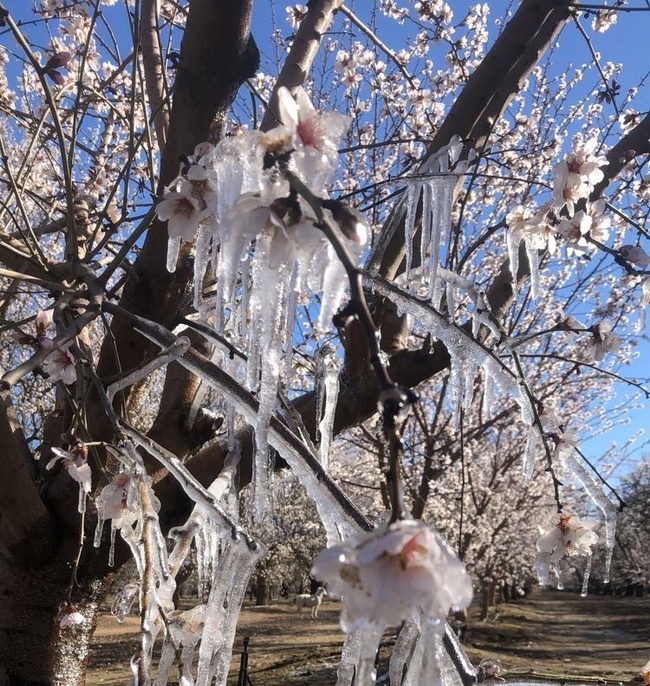
CalAgroClimate web tools help farmers prepare for frost events
A cold snap damaged almond blossoms across the Central Valley, resulting in more than $44 million in crop insurance claimsin late February 2018. A multi-day frost event wiped out roughly 75% of California's citrus crop and severely damaged avocados in January 2007. Frost can damage crops, impact growers' bottom lines and drive up food prices for consumers. With advance notice, farmers may be able to use heaters, wind machines, irrigation and other tactics to lessen some of the impacts of cold weather, such as damaging near-ripe citrus fruit or killing the bloom in almonds.
CalAgroClimate is a new farmer-focused website that can help growers anticipate weather-related risks and make plans for taking defensive action. Growers and crop consultants can use CalAgroClimate's crop and location-specific tools and resources to help prepare for upcoming frost events. The website's tools can also support on-farm decisions for managing heat, crop development and pests.
Future holds less frost
The risk of frost damage to crops and the need to prepare for that risk is top-of-mind for many farmers today, but will it always be so? To examine what climate change might mean for future frost risk, researchers at UC Davis, UC ANR and the USDA California Climate Hub conducted a study examining the incidence of temperatures below multiple “frost thresholds” during the months of critical development phases for three frost-sensitive California crops: almonds, avocados and navel oranges.
The researchers found that even during the coldest winters and springs, the incidence of frost exposure declined under projected mid-21st century climate conditions by more than 50% for almonds and oranges, and by more than 75% for avocados. While farmers in 2050 will not find frost risk to completely be a worry of climates past, they will not have to contend with the same frost concerns that farmers face today.
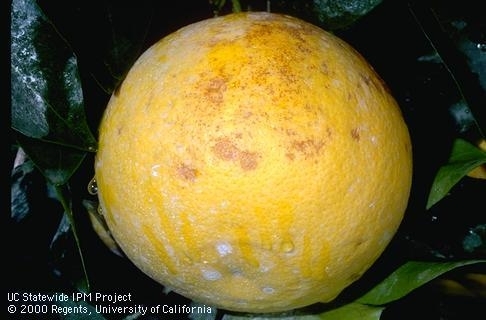
Few aspects of climate change are considered “positives,” and although the warming winters and springs that result in reduced frost temperatures could also come with increased pest pressure, reduced chill accumulation and other challenges, the reduction in frost exposure is a silver lining.
However, until this frost-free future arrives, growers still need to be prepared to protect their orchards from frost. To assess frost risk for the next seven days for your location, check out the new interactive Frost Advisory Tool at CalAgroClimate.org.
How to 'Bee My Valentine': Let's Help Out the UC Davis Biodiversity Museum Day
You can "Bee My Valentine" today--and throughout the month of February--by contributing to the UC Davis Biodiversity Museum Day. What is the UC Davis Biodiversity Museum Day? It's a free, open-to-the-public, science-based day that annually takes place the Saturday of Presidents' Day...
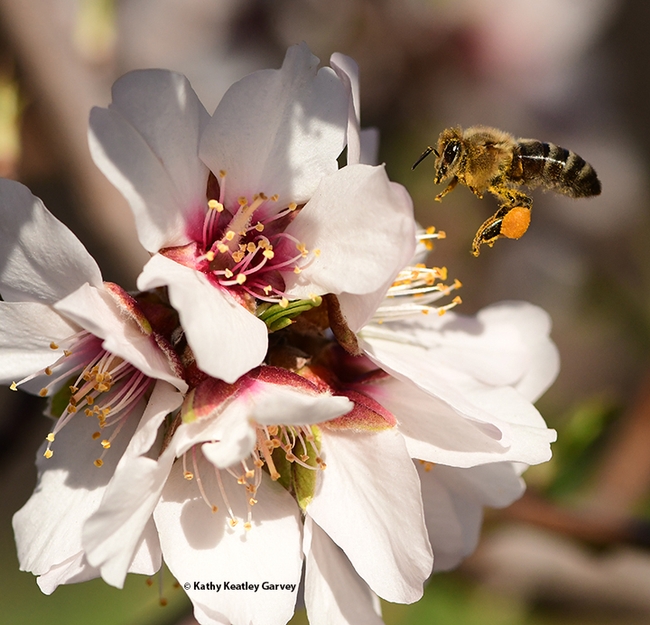
A honey bee, packing a load of orange pollen, heads for another almond blossom on Feb. 7, 2022 in Vacaville, Calif. Honey Bees are an integral part of the UC Davis Biodiversity Museum Day. (Photo by Kathy Keatley Garvey)
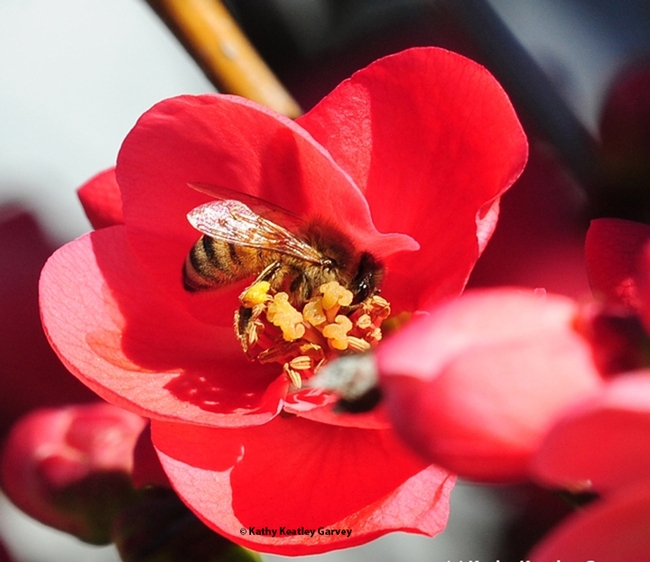
A honey bee foraging on a flowering quince. (Photo by Kathy Keatley Garvey)

